Clinical Integration Professional Practice
VerifiedAdded on 2022/10/02
|9
|2448
|168
AI Summary
This document discusses the case study of a patient with adenocarcinoma and the problems faced by the patient. It also reflects on the nursing care required for such patients. The document provides insights into the factors that can cause adenocarcinoma and the care plan required for the patient.
Contribute Materials
Your contribution can guide someone’s learning journey. Share your
documents today.
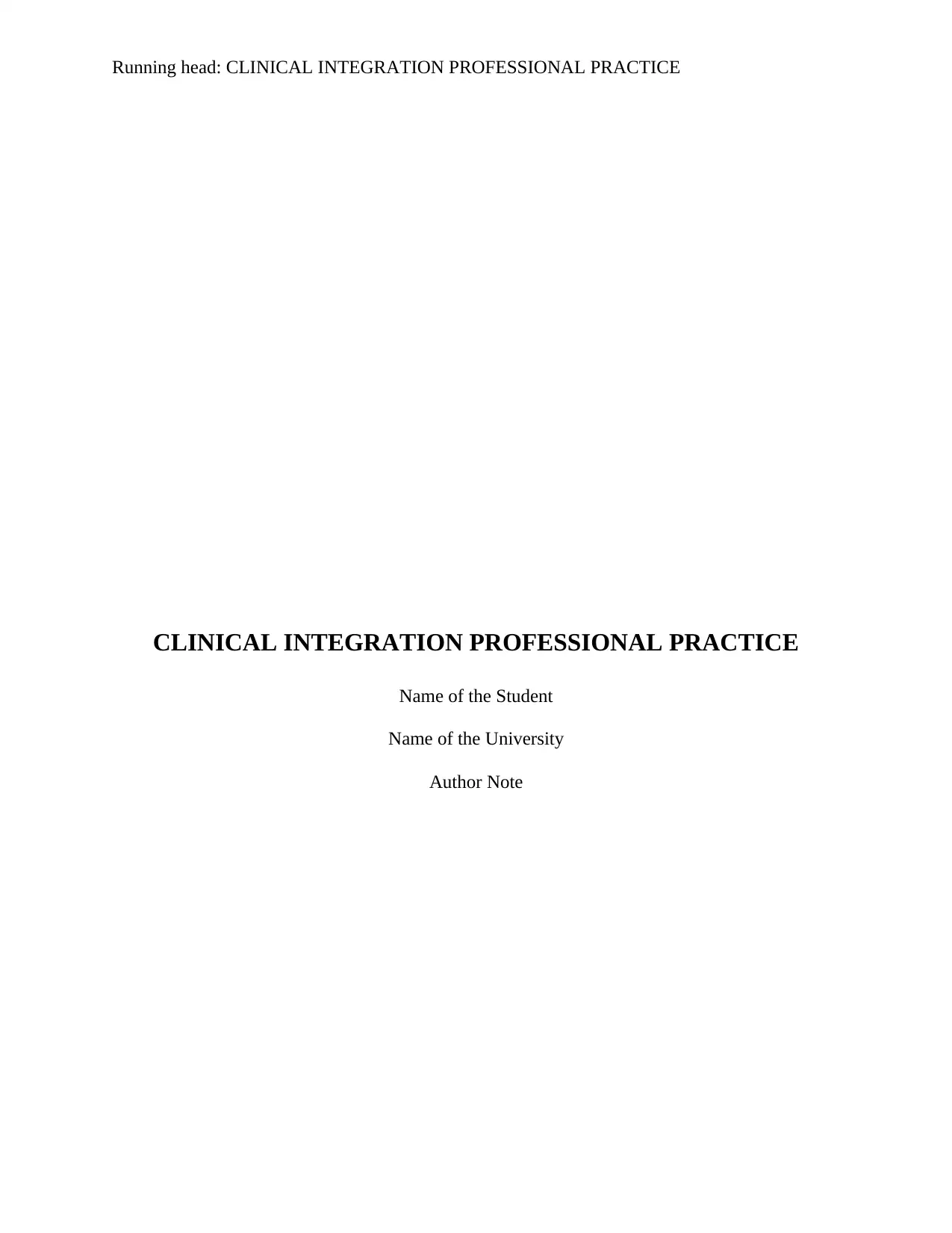
Running head: CLINICAL INTEGRATION PROFESSIONAL PRACTICE
CLINICAL INTEGRATION PROFESSIONAL PRACTICE
Name of the Student
Name of the University
Author Note
CLINICAL INTEGRATION PROFESSIONAL PRACTICE
Name of the Student
Name of the University
Author Note
Secure Best Marks with AI Grader
Need help grading? Try our AI Grader for instant feedback on your assignments.
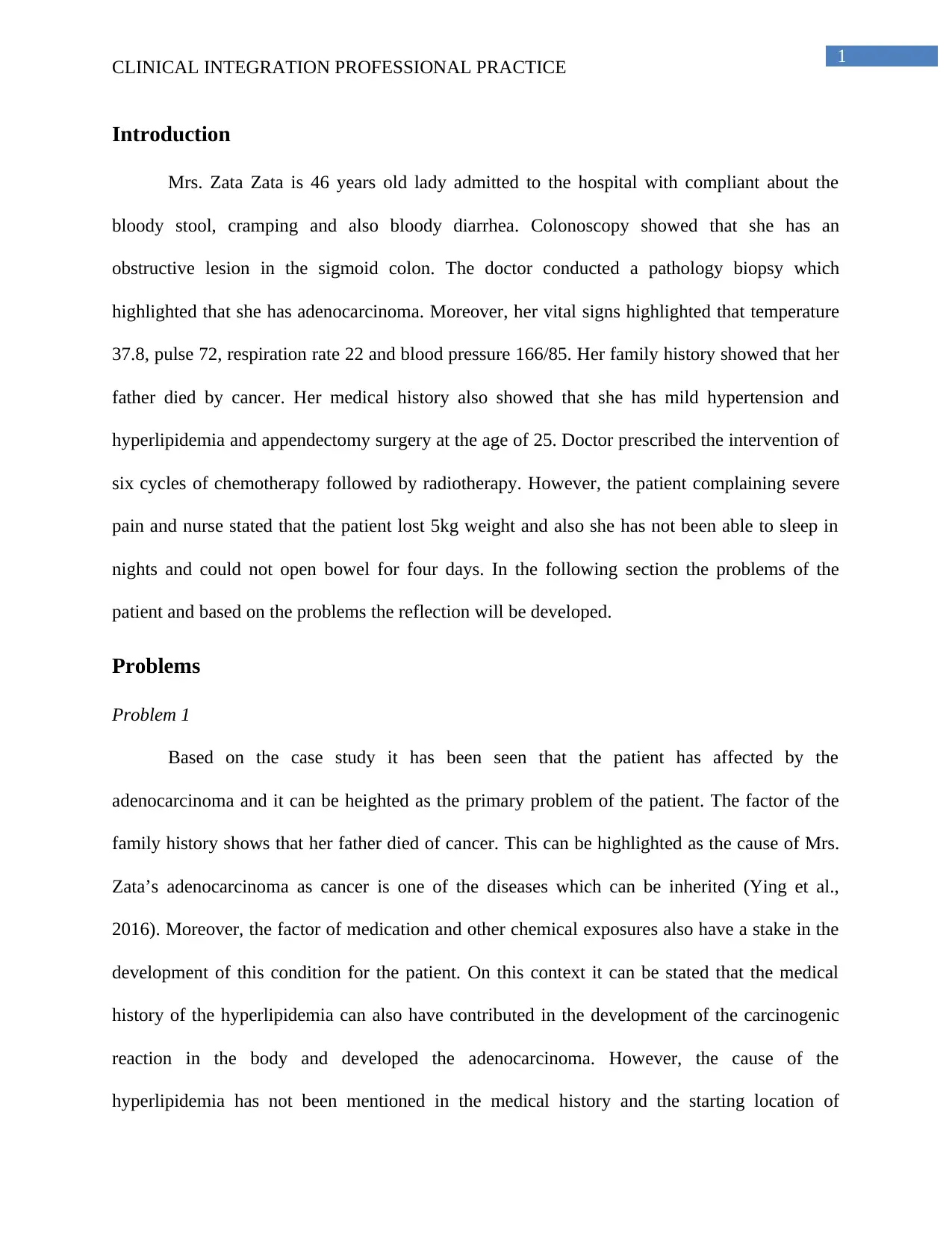
1
CLINICAL INTEGRATION PROFESSIONAL PRACTICE
Introduction
Mrs. Zata Zata is 46 years old lady admitted to the hospital with compliant about the
bloody stool, cramping and also bloody diarrhea. Colonoscopy showed that she has an
obstructive lesion in the sigmoid colon. The doctor conducted a pathology biopsy which
highlighted that she has adenocarcinoma. Moreover, her vital signs highlighted that temperature
37.8, pulse 72, respiration rate 22 and blood pressure 166/85. Her family history showed that her
father died by cancer. Her medical history also showed that she has mild hypertension and
hyperlipidemia and appendectomy surgery at the age of 25. Doctor prescribed the intervention of
six cycles of chemotherapy followed by radiotherapy. However, the patient complaining severe
pain and nurse stated that the patient lost 5kg weight and also she has not been able to sleep in
nights and could not open bowel for four days. In the following section the problems of the
patient and based on the problems the reflection will be developed.
Problems
Problem 1
Based on the case study it has been seen that the patient has affected by the
adenocarcinoma and it can be heighted as the primary problem of the patient. The factor of the
family history shows that her father died of cancer. This can be highlighted as the cause of Mrs.
Zata’s adenocarcinoma as cancer is one of the diseases which can be inherited (Ying et al.,
2016). Moreover, the factor of medication and other chemical exposures also have a stake in the
development of this condition for the patient. On this context it can be stated that the medical
history of the hyperlipidemia can also have contributed in the development of the carcinogenic
reaction in the body and developed the adenocarcinoma. However, the cause of the
hyperlipidemia has not been mentioned in the medical history and the starting location of
CLINICAL INTEGRATION PROFESSIONAL PRACTICE
Introduction
Mrs. Zata Zata is 46 years old lady admitted to the hospital with compliant about the
bloody stool, cramping and also bloody diarrhea. Colonoscopy showed that she has an
obstructive lesion in the sigmoid colon. The doctor conducted a pathology biopsy which
highlighted that she has adenocarcinoma. Moreover, her vital signs highlighted that temperature
37.8, pulse 72, respiration rate 22 and blood pressure 166/85. Her family history showed that her
father died by cancer. Her medical history also showed that she has mild hypertension and
hyperlipidemia and appendectomy surgery at the age of 25. Doctor prescribed the intervention of
six cycles of chemotherapy followed by radiotherapy. However, the patient complaining severe
pain and nurse stated that the patient lost 5kg weight and also she has not been able to sleep in
nights and could not open bowel for four days. In the following section the problems of the
patient and based on the problems the reflection will be developed.
Problems
Problem 1
Based on the case study it has been seen that the patient has affected by the
adenocarcinoma and it can be heighted as the primary problem of the patient. The factor of the
family history shows that her father died of cancer. This can be highlighted as the cause of Mrs.
Zata’s adenocarcinoma as cancer is one of the diseases which can be inherited (Ying et al.,
2016). Moreover, the factor of medication and other chemical exposures also have a stake in the
development of this condition for the patient. On this context it can be stated that the medical
history of the hyperlipidemia can also have contributed in the development of the carcinogenic
reaction in the body and developed the adenocarcinoma. However, the cause of the
hyperlipidemia has not been mentioned in the medical history and the starting location of
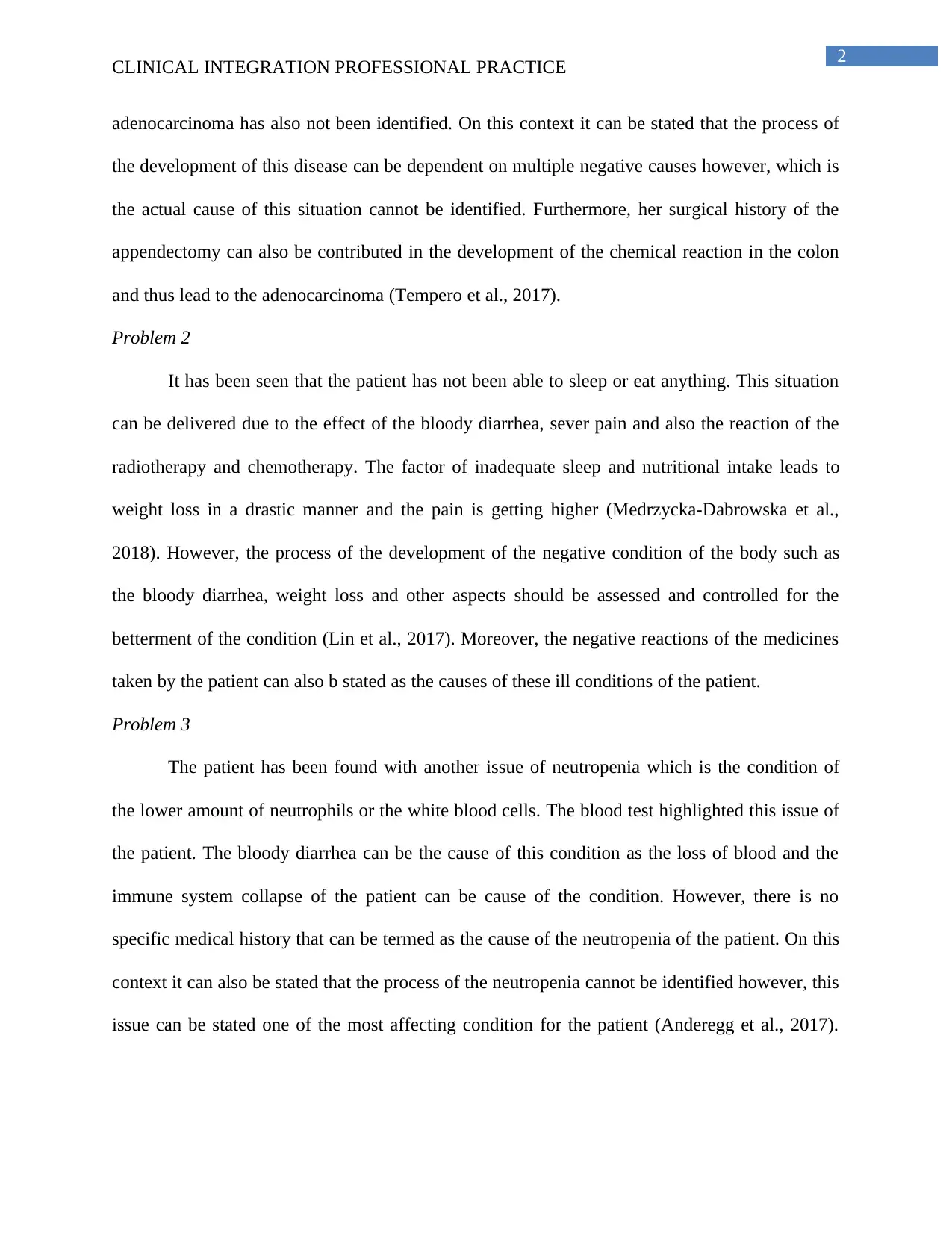
2
CLINICAL INTEGRATION PROFESSIONAL PRACTICE
adenocarcinoma has also not been identified. On this context it can be stated that the process of
the development of this disease can be dependent on multiple negative causes however, which is
the actual cause of this situation cannot be identified. Furthermore, her surgical history of the
appendectomy can also be contributed in the development of the chemical reaction in the colon
and thus lead to the adenocarcinoma (Tempero et al., 2017).
Problem 2
It has been seen that the patient has not been able to sleep or eat anything. This situation
can be delivered due to the effect of the bloody diarrhea, sever pain and also the reaction of the
radiotherapy and chemotherapy. The factor of inadequate sleep and nutritional intake leads to
weight loss in a drastic manner and the pain is getting higher (Medrzycka-Dabrowska et al.,
2018). However, the process of the development of the negative condition of the body such as
the bloody diarrhea, weight loss and other aspects should be assessed and controlled for the
betterment of the condition (Lin et al., 2017). Moreover, the negative reactions of the medicines
taken by the patient can also b stated as the causes of these ill conditions of the patient.
Problem 3
The patient has been found with another issue of neutropenia which is the condition of
the lower amount of neutrophils or the white blood cells. The blood test highlighted this issue of
the patient. The bloody diarrhea can be the cause of this condition as the loss of blood and the
immune system collapse of the patient can be cause of the condition. However, there is no
specific medical history that can be termed as the cause of the neutropenia of the patient. On this
context it can also be stated that the process of the neutropenia cannot be identified however, this
issue can be stated one of the most affecting condition for the patient (Anderegg et al., 2017).
CLINICAL INTEGRATION PROFESSIONAL PRACTICE
adenocarcinoma has also not been identified. On this context it can be stated that the process of
the development of this disease can be dependent on multiple negative causes however, which is
the actual cause of this situation cannot be identified. Furthermore, her surgical history of the
appendectomy can also be contributed in the development of the chemical reaction in the colon
and thus lead to the adenocarcinoma (Tempero et al., 2017).
Problem 2
It has been seen that the patient has not been able to sleep or eat anything. This situation
can be delivered due to the effect of the bloody diarrhea, sever pain and also the reaction of the
radiotherapy and chemotherapy. The factor of inadequate sleep and nutritional intake leads to
weight loss in a drastic manner and the pain is getting higher (Medrzycka-Dabrowska et al.,
2018). However, the process of the development of the negative condition of the body such as
the bloody diarrhea, weight loss and other aspects should be assessed and controlled for the
betterment of the condition (Lin et al., 2017). Moreover, the negative reactions of the medicines
taken by the patient can also b stated as the causes of these ill conditions of the patient.
Problem 3
The patient has been found with another issue of neutropenia which is the condition of
the lower amount of neutrophils or the white blood cells. The blood test highlighted this issue of
the patient. The bloody diarrhea can be the cause of this condition as the loss of blood and the
immune system collapse of the patient can be cause of the condition. However, there is no
specific medical history that can be termed as the cause of the neutropenia of the patient. On this
context it can also be stated that the process of the neutropenia cannot be identified however, this
issue can be stated one of the most affecting condition for the patient (Anderegg et al., 2017).
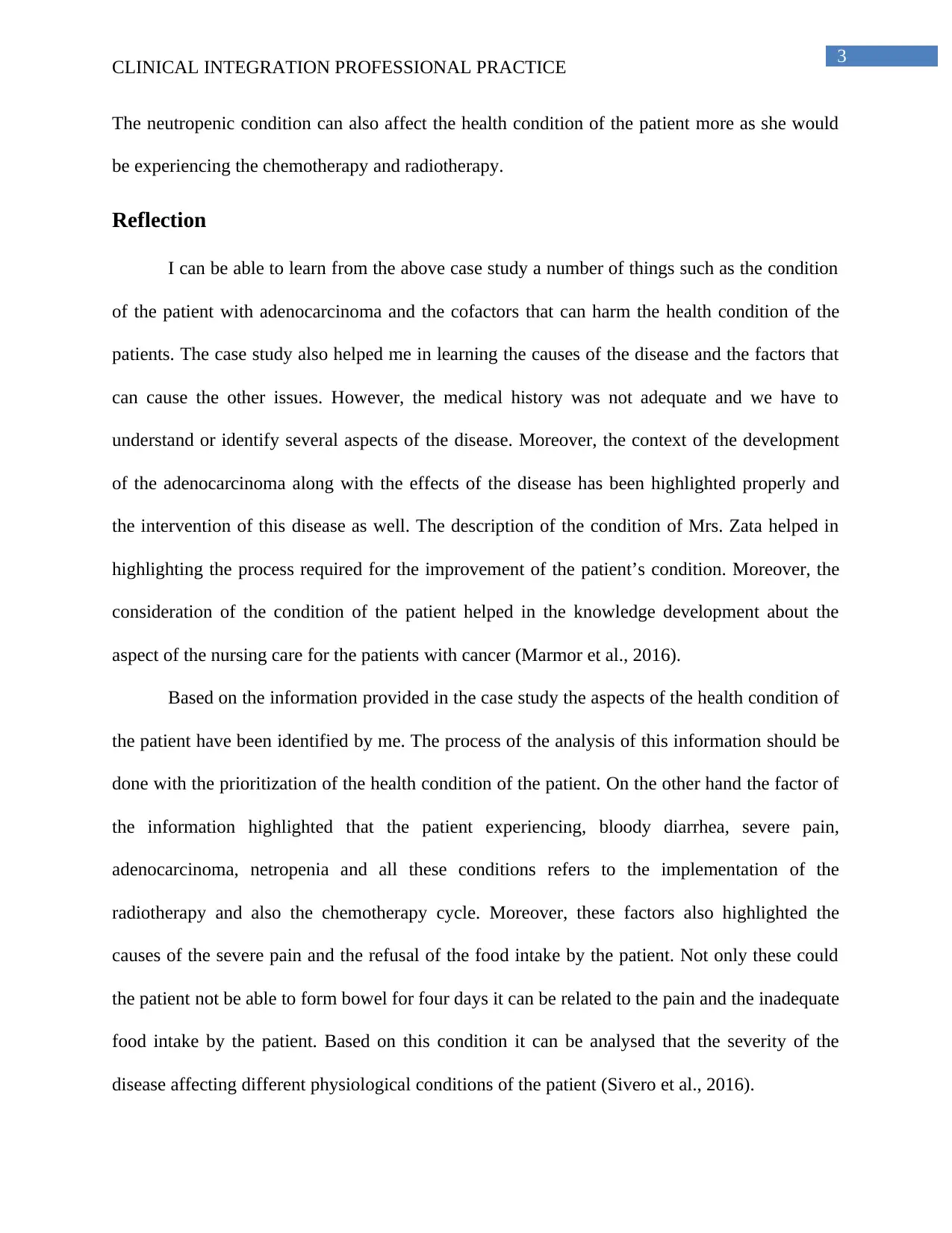
3
CLINICAL INTEGRATION PROFESSIONAL PRACTICE
The neutropenic condition can also affect the health condition of the patient more as she would
be experiencing the chemotherapy and radiotherapy.
Reflection
I can be able to learn from the above case study a number of things such as the condition
of the patient with adenocarcinoma and the cofactors that can harm the health condition of the
patients. The case study also helped me in learning the causes of the disease and the factors that
can cause the other issues. However, the medical history was not adequate and we have to
understand or identify several aspects of the disease. Moreover, the context of the development
of the adenocarcinoma along with the effects of the disease has been highlighted properly and
the intervention of this disease as well. The description of the condition of Mrs. Zata helped in
highlighting the process required for the improvement of the patient’s condition. Moreover, the
consideration of the condition of the patient helped in the knowledge development about the
aspect of the nursing care for the patients with cancer (Marmor et al., 2016).
Based on the information provided in the case study the aspects of the health condition of
the patient have been identified by me. The process of the analysis of this information should be
done with the prioritization of the health condition of the patient. On the other hand the factor of
the information highlighted that the patient experiencing, bloody diarrhea, severe pain,
adenocarcinoma, netropenia and all these conditions refers to the implementation of the
radiotherapy and also the chemotherapy cycle. Moreover, these factors also highlighted the
causes of the severe pain and the refusal of the food intake by the patient. Not only these could
the patient not be able to form bowel for four days it can be related to the pain and the inadequate
food intake by the patient. Based on this condition it can be analysed that the severity of the
disease affecting different physiological conditions of the patient (Sivero et al., 2016).
CLINICAL INTEGRATION PROFESSIONAL PRACTICE
The neutropenic condition can also affect the health condition of the patient more as she would
be experiencing the chemotherapy and radiotherapy.
Reflection
I can be able to learn from the above case study a number of things such as the condition
of the patient with adenocarcinoma and the cofactors that can harm the health condition of the
patients. The case study also helped me in learning the causes of the disease and the factors that
can cause the other issues. However, the medical history was not adequate and we have to
understand or identify several aspects of the disease. Moreover, the context of the development
of the adenocarcinoma along with the effects of the disease has been highlighted properly and
the intervention of this disease as well. The description of the condition of Mrs. Zata helped in
highlighting the process required for the improvement of the patient’s condition. Moreover, the
consideration of the condition of the patient helped in the knowledge development about the
aspect of the nursing care for the patients with cancer (Marmor et al., 2016).
Based on the information provided in the case study the aspects of the health condition of
the patient have been identified by me. The process of the analysis of this information should be
done with the prioritization of the health condition of the patient. On the other hand the factor of
the information highlighted that the patient experiencing, bloody diarrhea, severe pain,
adenocarcinoma, netropenia and all these conditions refers to the implementation of the
radiotherapy and also the chemotherapy cycle. Moreover, these factors also highlighted the
causes of the severe pain and the refusal of the food intake by the patient. Not only these could
the patient not be able to form bowel for four days it can be related to the pain and the inadequate
food intake by the patient. Based on this condition it can be analysed that the severity of the
disease affecting different physiological conditions of the patient (Sivero et al., 2016).
Secure Best Marks with AI Grader
Need help grading? Try our AI Grader for instant feedback on your assignments.
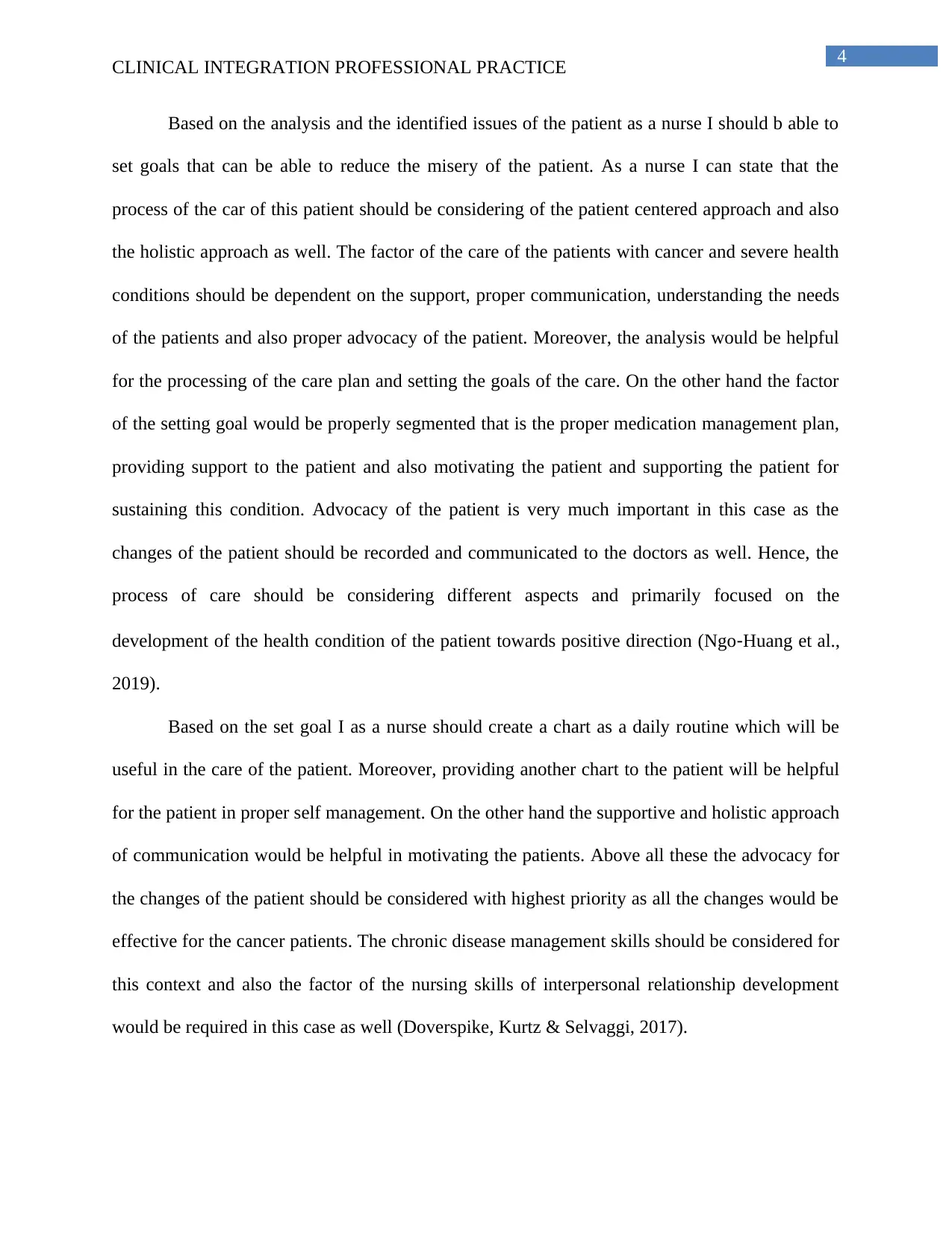
4
CLINICAL INTEGRATION PROFESSIONAL PRACTICE
Based on the analysis and the identified issues of the patient as a nurse I should b able to
set goals that can be able to reduce the misery of the patient. As a nurse I can state that the
process of the car of this patient should be considering of the patient centered approach and also
the holistic approach as well. The factor of the care of the patients with cancer and severe health
conditions should be dependent on the support, proper communication, understanding the needs
of the patients and also proper advocacy of the patient. Moreover, the analysis would be helpful
for the processing of the care plan and setting the goals of the care. On the other hand the factor
of the setting goal would be properly segmented that is the proper medication management plan,
providing support to the patient and also motivating the patient and supporting the patient for
sustaining this condition. Advocacy of the patient is very much important in this case as the
changes of the patient should be recorded and communicated to the doctors as well. Hence, the
process of care should be considering different aspects and primarily focused on the
development of the health condition of the patient towards positive direction (Ngo‐Huang et al.,
2019).
Based on the set goal I as a nurse should create a chart as a daily routine which will be
useful in the care of the patient. Moreover, providing another chart to the patient will be helpful
for the patient in proper self management. On the other hand the supportive and holistic approach
of communication would be helpful in motivating the patients. Above all these the advocacy for
the changes of the patient should be considered with highest priority as all the changes would be
effective for the cancer patients. The chronic disease management skills should be considered for
this context and also the factor of the nursing skills of interpersonal relationship development
would be required in this case as well (Doverspike, Kurtz & Selvaggi, 2017).
CLINICAL INTEGRATION PROFESSIONAL PRACTICE
Based on the analysis and the identified issues of the patient as a nurse I should b able to
set goals that can be able to reduce the misery of the patient. As a nurse I can state that the
process of the car of this patient should be considering of the patient centered approach and also
the holistic approach as well. The factor of the care of the patients with cancer and severe health
conditions should be dependent on the support, proper communication, understanding the needs
of the patients and also proper advocacy of the patient. Moreover, the analysis would be helpful
for the processing of the care plan and setting the goals of the care. On the other hand the factor
of the setting goal would be properly segmented that is the proper medication management plan,
providing support to the patient and also motivating the patient and supporting the patient for
sustaining this condition. Advocacy of the patient is very much important in this case as the
changes of the patient should be recorded and communicated to the doctors as well. Hence, the
process of care should be considering different aspects and primarily focused on the
development of the health condition of the patient towards positive direction (Ngo‐Huang et al.,
2019).
Based on the set goal I as a nurse should create a chart as a daily routine which will be
useful in the care of the patient. Moreover, providing another chart to the patient will be helpful
for the patient in proper self management. On the other hand the supportive and holistic approach
of communication would be helpful in motivating the patients. Above all these the advocacy for
the changes of the patient should be considered with highest priority as all the changes would be
effective for the cancer patients. The chronic disease management skills should be considered for
this context and also the factor of the nursing skills of interpersonal relationship development
would be required in this case as well (Doverspike, Kurtz & Selvaggi, 2017).
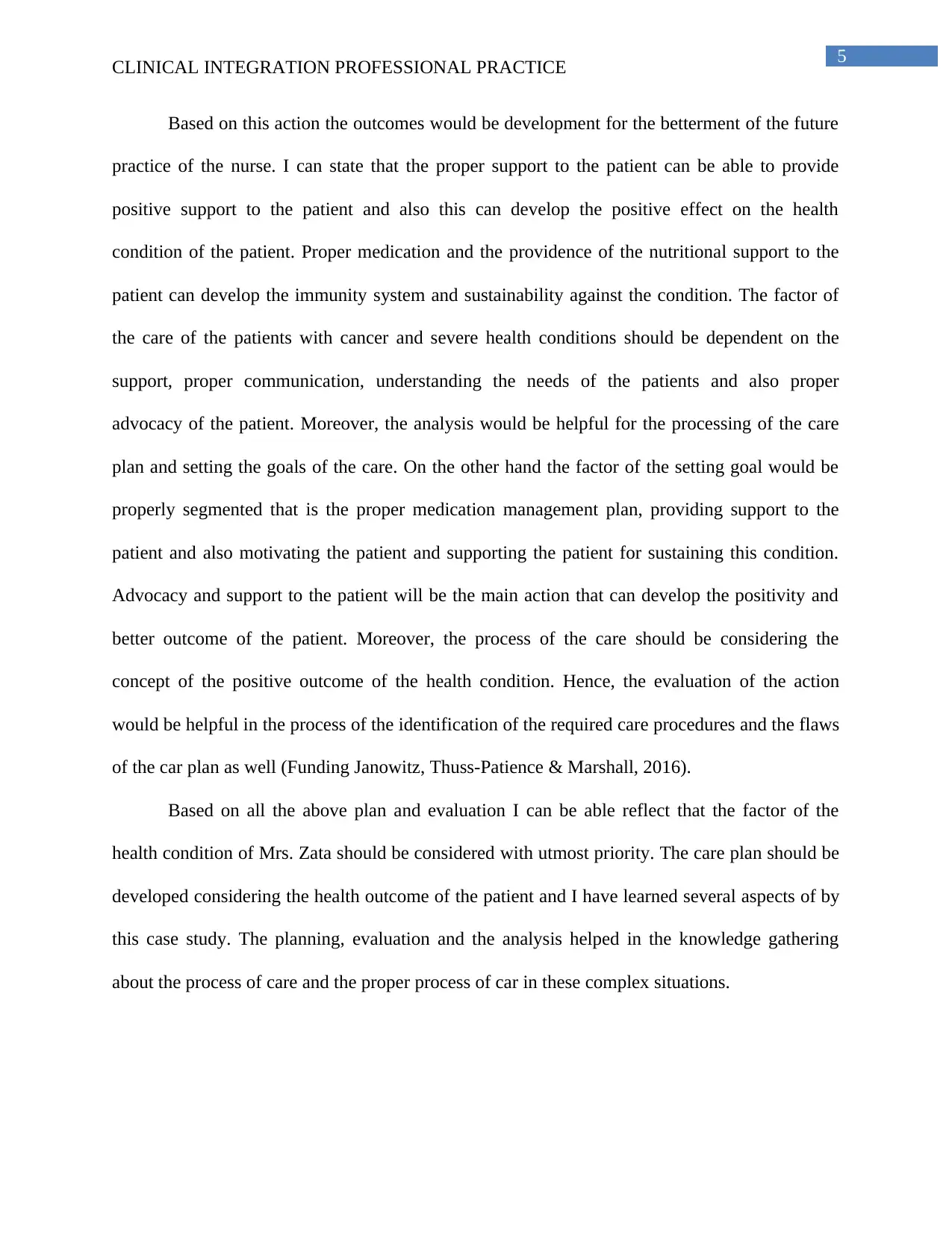
5
CLINICAL INTEGRATION PROFESSIONAL PRACTICE
Based on this action the outcomes would be development for the betterment of the future
practice of the nurse. I can state that the proper support to the patient can be able to provide
positive support to the patient and also this can develop the positive effect on the health
condition of the patient. Proper medication and the providence of the nutritional support to the
patient can develop the immunity system and sustainability against the condition. The factor of
the care of the patients with cancer and severe health conditions should be dependent on the
support, proper communication, understanding the needs of the patients and also proper
advocacy of the patient. Moreover, the analysis would be helpful for the processing of the care
plan and setting the goals of the care. On the other hand the factor of the setting goal would be
properly segmented that is the proper medication management plan, providing support to the
patient and also motivating the patient and supporting the patient for sustaining this condition.
Advocacy and support to the patient will be the main action that can develop the positivity and
better outcome of the patient. Moreover, the process of the care should be considering the
concept of the positive outcome of the health condition. Hence, the evaluation of the action
would be helpful in the process of the identification of the required care procedures and the flaws
of the car plan as well (Funding Janowitz, Thuss-Patience & Marshall, 2016).
Based on all the above plan and evaluation I can be able reflect that the factor of the
health condition of Mrs. Zata should be considered with utmost priority. The care plan should be
developed considering the health outcome of the patient and I have learned several aspects of by
this case study. The planning, evaluation and the analysis helped in the knowledge gathering
about the process of care and the proper process of car in these complex situations.
CLINICAL INTEGRATION PROFESSIONAL PRACTICE
Based on this action the outcomes would be development for the betterment of the future
practice of the nurse. I can state that the proper support to the patient can be able to provide
positive support to the patient and also this can develop the positive effect on the health
condition of the patient. Proper medication and the providence of the nutritional support to the
patient can develop the immunity system and sustainability against the condition. The factor of
the care of the patients with cancer and severe health conditions should be dependent on the
support, proper communication, understanding the needs of the patients and also proper
advocacy of the patient. Moreover, the analysis would be helpful for the processing of the care
plan and setting the goals of the care. On the other hand the factor of the setting goal would be
properly segmented that is the proper medication management plan, providing support to the
patient and also motivating the patient and supporting the patient for sustaining this condition.
Advocacy and support to the patient will be the main action that can develop the positivity and
better outcome of the patient. Moreover, the process of the care should be considering the
concept of the positive outcome of the health condition. Hence, the evaluation of the action
would be helpful in the process of the identification of the required care procedures and the flaws
of the car plan as well (Funding Janowitz, Thuss-Patience & Marshall, 2016).
Based on all the above plan and evaluation I can be able reflect that the factor of the
health condition of Mrs. Zata should be considered with utmost priority. The care plan should be
developed considering the health outcome of the patient and I have learned several aspects of by
this case study. The planning, evaluation and the analysis helped in the knowledge gathering
about the process of care and the proper process of car in these complex situations.
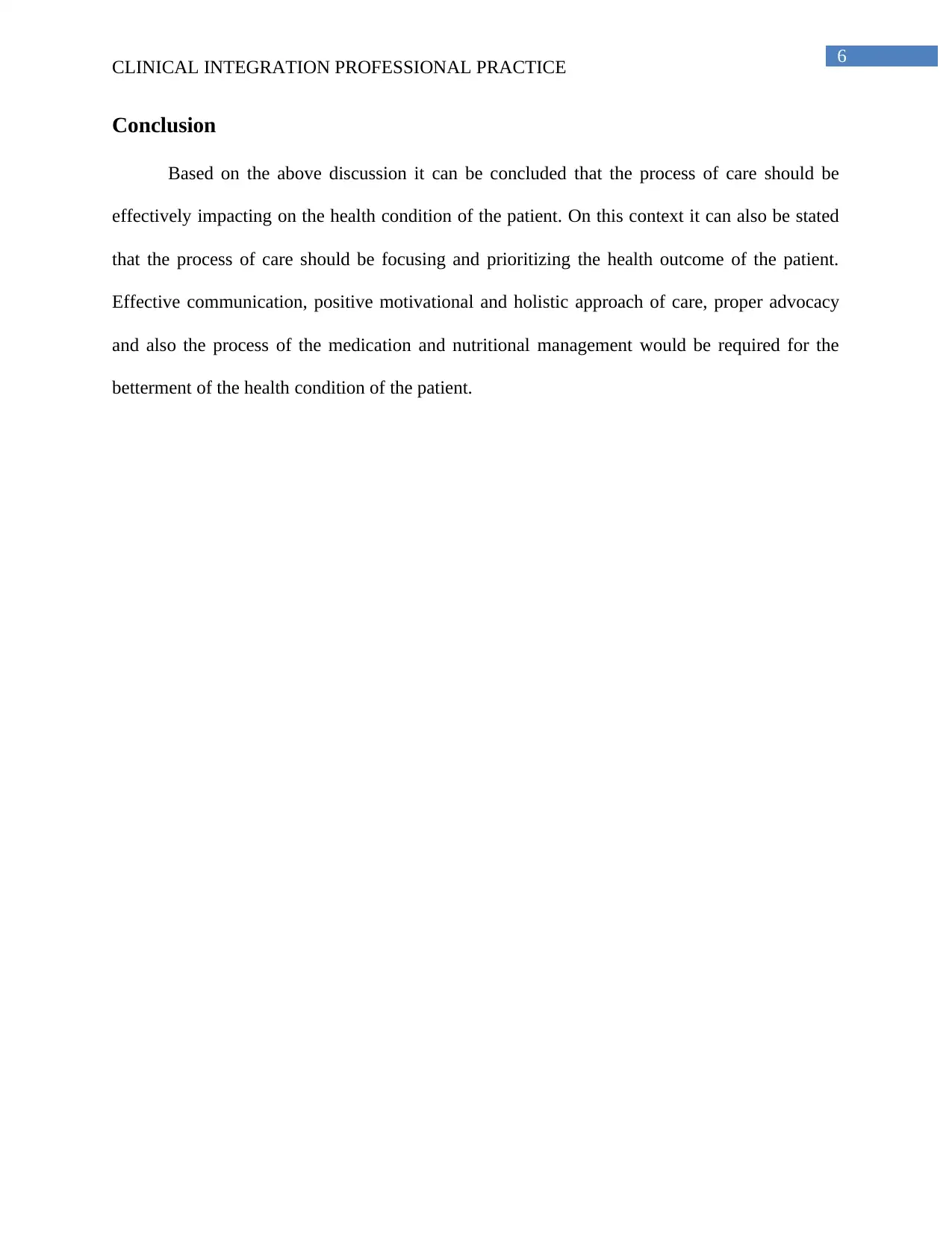
6
CLINICAL INTEGRATION PROFESSIONAL PRACTICE
Conclusion
Based on the above discussion it can be concluded that the process of care should be
effectively impacting on the health condition of the patient. On this context it can also be stated
that the process of care should be focusing and prioritizing the health outcome of the patient.
Effective communication, positive motivational and holistic approach of care, proper advocacy
and also the process of the medication and nutritional management would be required for the
betterment of the health condition of the patient.
CLINICAL INTEGRATION PROFESSIONAL PRACTICE
Conclusion
Based on the above discussion it can be concluded that the process of care should be
effectively impacting on the health condition of the patient. On this context it can also be stated
that the process of care should be focusing and prioritizing the health outcome of the patient.
Effective communication, positive motivational and holistic approach of care, proper advocacy
and also the process of the medication and nutritional management would be required for the
betterment of the health condition of the patient.
Paraphrase This Document
Need a fresh take? Get an instant paraphrase of this document with our AI Paraphraser
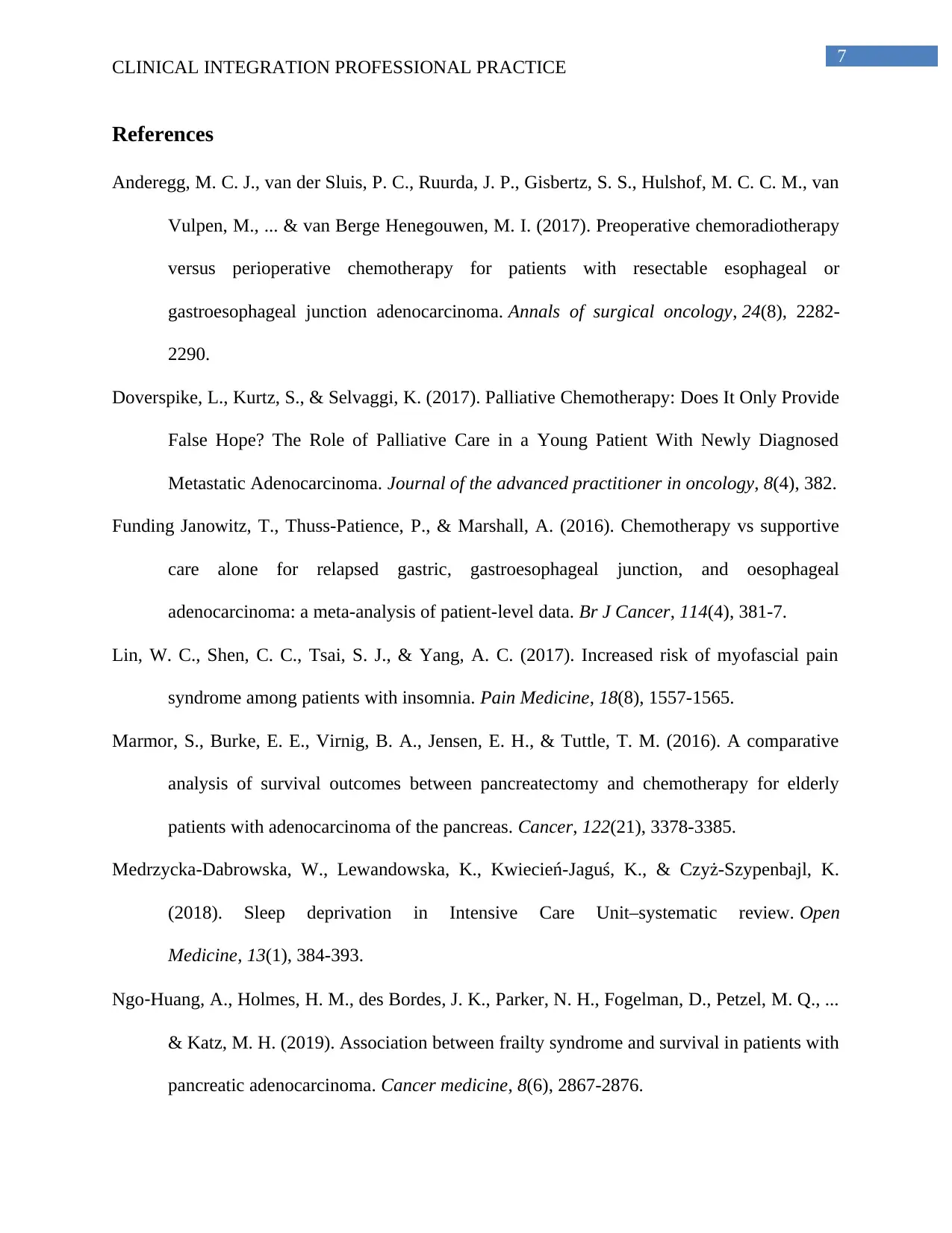
7
CLINICAL INTEGRATION PROFESSIONAL PRACTICE
References
Anderegg, M. C. J., van der Sluis, P. C., Ruurda, J. P., Gisbertz, S. S., Hulshof, M. C. C. M., van
Vulpen, M., ... & van Berge Henegouwen, M. I. (2017). Preoperative chemoradiotherapy
versus perioperative chemotherapy for patients with resectable esophageal or
gastroesophageal junction adenocarcinoma. Annals of surgical oncology, 24(8), 2282-
2290.
Doverspike, L., Kurtz, S., & Selvaggi, K. (2017). Palliative Chemotherapy: Does It Only Provide
False Hope? The Role of Palliative Care in a Young Patient With Newly Diagnosed
Metastatic Adenocarcinoma. Journal of the advanced practitioner in oncology, 8(4), 382.
Funding Janowitz, T., Thuss-Patience, P., & Marshall, A. (2016). Chemotherapy vs supportive
care alone for relapsed gastric, gastroesophageal junction, and oesophageal
adenocarcinoma: a meta-analysis of patient-level data. Br J Cancer, 114(4), 381-7.
Lin, W. C., Shen, C. C., Tsai, S. J., & Yang, A. C. (2017). Increased risk of myofascial pain
syndrome among patients with insomnia. Pain Medicine, 18(8), 1557-1565.
Marmor, S., Burke, E. E., Virnig, B. A., Jensen, E. H., & Tuttle, T. M. (2016). A comparative
analysis of survival outcomes between pancreatectomy and chemotherapy for elderly
patients with adenocarcinoma of the pancreas. Cancer, 122(21), 3378-3385.
Medrzycka-Dabrowska, W., Lewandowska, K., Kwiecień-Jaguś, K., & Czyż-Szypenbajl, K.
(2018). Sleep deprivation in Intensive Care Unit–systematic review. Open
Medicine, 13(1), 384-393.
Ngo‐Huang, A., Holmes, H. M., des Bordes, J. K., Parker, N. H., Fogelman, D., Petzel, M. Q., ...
& Katz, M. H. (2019). Association between frailty syndrome and survival in patients with
pancreatic adenocarcinoma. Cancer medicine, 8(6), 2867-2876.
CLINICAL INTEGRATION PROFESSIONAL PRACTICE
References
Anderegg, M. C. J., van der Sluis, P. C., Ruurda, J. P., Gisbertz, S. S., Hulshof, M. C. C. M., van
Vulpen, M., ... & van Berge Henegouwen, M. I. (2017). Preoperative chemoradiotherapy
versus perioperative chemotherapy for patients with resectable esophageal or
gastroesophageal junction adenocarcinoma. Annals of surgical oncology, 24(8), 2282-
2290.
Doverspike, L., Kurtz, S., & Selvaggi, K. (2017). Palliative Chemotherapy: Does It Only Provide
False Hope? The Role of Palliative Care in a Young Patient With Newly Diagnosed
Metastatic Adenocarcinoma. Journal of the advanced practitioner in oncology, 8(4), 382.
Funding Janowitz, T., Thuss-Patience, P., & Marshall, A. (2016). Chemotherapy vs supportive
care alone for relapsed gastric, gastroesophageal junction, and oesophageal
adenocarcinoma: a meta-analysis of patient-level data. Br J Cancer, 114(4), 381-7.
Lin, W. C., Shen, C. C., Tsai, S. J., & Yang, A. C. (2017). Increased risk of myofascial pain
syndrome among patients with insomnia. Pain Medicine, 18(8), 1557-1565.
Marmor, S., Burke, E. E., Virnig, B. A., Jensen, E. H., & Tuttle, T. M. (2016). A comparative
analysis of survival outcomes between pancreatectomy and chemotherapy for elderly
patients with adenocarcinoma of the pancreas. Cancer, 122(21), 3378-3385.
Medrzycka-Dabrowska, W., Lewandowska, K., Kwiecień-Jaguś, K., & Czyż-Szypenbajl, K.
(2018). Sleep deprivation in Intensive Care Unit–systematic review. Open
Medicine, 13(1), 384-393.
Ngo‐Huang, A., Holmes, H. M., des Bordes, J. K., Parker, N. H., Fogelman, D., Petzel, M. Q., ...
& Katz, M. H. (2019). Association between frailty syndrome and survival in patients with
pancreatic adenocarcinoma. Cancer medicine, 8(6), 2867-2876.
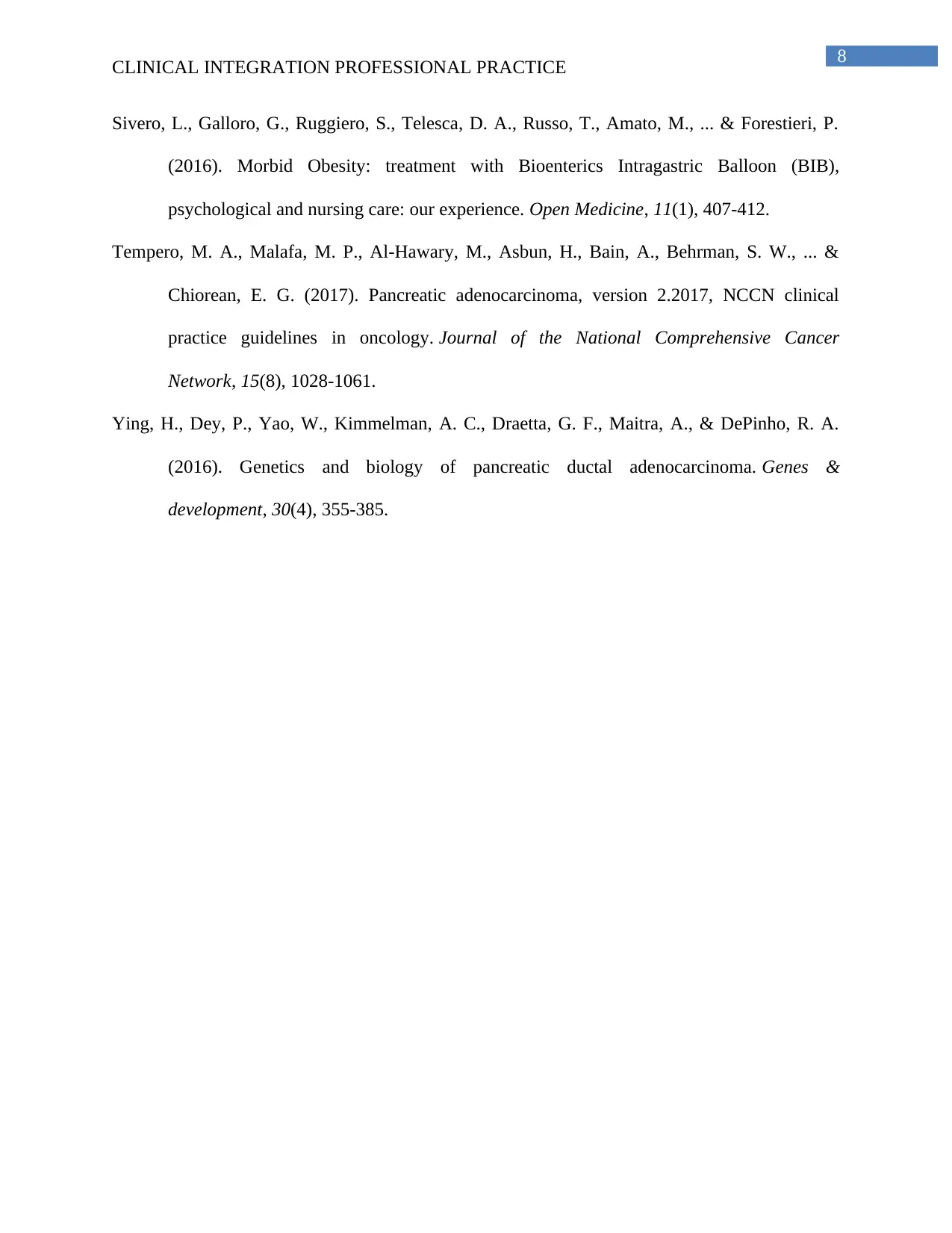
8
CLINICAL INTEGRATION PROFESSIONAL PRACTICE
Sivero, L., Galloro, G., Ruggiero, S., Telesca, D. A., Russo, T., Amato, M., ... & Forestieri, P.
(2016). Morbid Obesity: treatment with Bioenterics Intragastric Balloon (BIB),
psychological and nursing care: our experience. Open Medicine, 11(1), 407-412.
Tempero, M. A., Malafa, M. P., Al-Hawary, M., Asbun, H., Bain, A., Behrman, S. W., ... &
Chiorean, E. G. (2017). Pancreatic adenocarcinoma, version 2.2017, NCCN clinical
practice guidelines in oncology. Journal of the National Comprehensive Cancer
Network, 15(8), 1028-1061.
Ying, H., Dey, P., Yao, W., Kimmelman, A. C., Draetta, G. F., Maitra, A., & DePinho, R. A.
(2016). Genetics and biology of pancreatic ductal adenocarcinoma. Genes &
development, 30(4), 355-385.
CLINICAL INTEGRATION PROFESSIONAL PRACTICE
Sivero, L., Galloro, G., Ruggiero, S., Telesca, D. A., Russo, T., Amato, M., ... & Forestieri, P.
(2016). Morbid Obesity: treatment with Bioenterics Intragastric Balloon (BIB),
psychological and nursing care: our experience. Open Medicine, 11(1), 407-412.
Tempero, M. A., Malafa, M. P., Al-Hawary, M., Asbun, H., Bain, A., Behrman, S. W., ... &
Chiorean, E. G. (2017). Pancreatic adenocarcinoma, version 2.2017, NCCN clinical
practice guidelines in oncology. Journal of the National Comprehensive Cancer
Network, 15(8), 1028-1061.
Ying, H., Dey, P., Yao, W., Kimmelman, A. C., Draetta, G. F., Maitra, A., & DePinho, R. A.
(2016). Genetics and biology of pancreatic ductal adenocarcinoma. Genes &
development, 30(4), 355-385.
1 out of 9
Related Documents
Your All-in-One AI-Powered Toolkit for Academic Success.
+13062052269
info@desklib.com
Available 24*7 on WhatsApp / Email
![[object Object]](/_next/static/media/star-bottom.7253800d.svg)
Unlock your academic potential
© 2024 | Zucol Services PVT LTD | All rights reserved.





